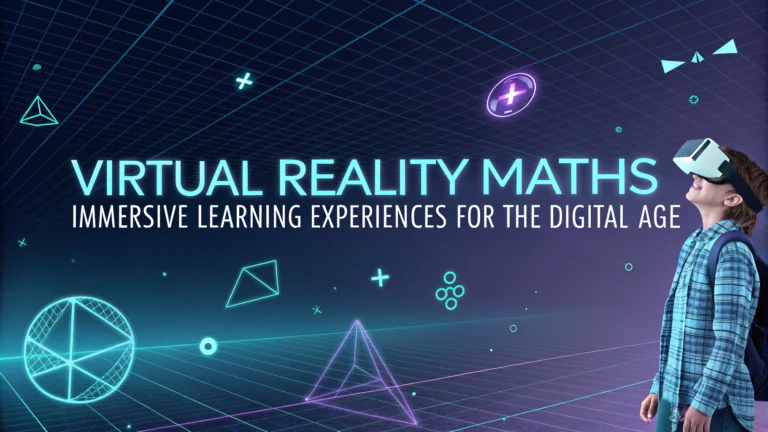Imagine stepping into a 3D world where numbers come alive and equations float in mid-air. Virtual Reality (VR) is revolutionizing how students learn maths, making it more engaging and interactive than ever before.
This article explores how VR transforms maths education, its benefits for different age groups, and practical ways to incorporate it into learning. We’ll also look at some popular VR maths applications and address common concerns.
How VR Enhances Maths Learning
VR creates immersive environments that bring abstract mathematical concepts to life. Students can manipulate 3D shapes, walk through geometric structures, and visualize complex problems in ways previously impossible.
- Visualization: Makes abstract concepts tangible
- Interactivity: Allows hands-on exploration of mathematical principles
- Engagement: Increases student interest and motivation
- Personalization: Adapts to individual learning styles and paces
VR Maths Applications for Different Age Groups
Elementary School (Ages 5-11)
- Number Sense: Virtual counting games and number lines
- Basic Operations: Interactive addition, subtraction, multiplication, and division scenarios
- Shapes and Patterns: 3D shape exploration and pattern recognition
Middle School (Ages 11-14)
- Geometry: Virtual construction of 2D and 3D shapes
- Algebra: Interactive equation solving and graphing
- Data and Statistics: Immersive data visualization experiences
High School (Ages 14-18)
- Trigonometry: 3D angle and distance calculations
- Calculus: Visual representations of limits, derivatives, and integrals
- Complex Functions: Exploration of multivariable functions in 3D space
Implementing VR in Maths Education
Integrating VR into maths curricula requires planning and resources. Here are some steps to get started:
- Assess your needs: Determine which areas of maths would benefit most from VR
- Choose appropriate hardware: Select VR headsets suitable for your budget and age group
- Select software: Find VR maths applications aligned with your curriculum
- Train teachers: Provide professional development on using VR in maths instruction
- Create lesson plans: Develop VR-enhanced lessons that complement traditional teaching
Remember to start small and gradually expand your VR maths program as you gain experience and see results.
Overcoming Challenges in VR Maths Education
Despite its potential, implementing VR in maths education faces several hurdles:
- Cost: High-quality VR equipment can be expensive for schools
- Technical issues: Hardware and software glitches can disrupt lessons
- Motion sickness: Some students may experience discomfort in VR environments
- Limited content: Lack of comprehensive VR maths curricula for all grade levels
To address these challenges:
- Start with a small pilot program to assess feasibility
- Seek grants or partnerships to fund VR initiatives
- Provide proper training for teachers and IT staff
- Limit VR session durations to prevent motion sickness
- Collaborate with developers to create custom VR maths content
Measuring the Impact of VR on Maths Learning
To ensure VR is effectively enhancing maths education, it’s essential to measure its impact:
- Pre and post-assessments: Compare student performance before and after VR implementation
- Engagement metrics: Track time spent in VR environments and participation rates
- Qualitative feedback: Gather input from students and teachers on the VR experience
- Long-term retention: Assess how well students retain concepts learned through VR
Use this data to refine your VR maths program and demonstrate its value to stakeholders.
Future Trends in VR Maths Education
The field of VR maths education is rapidly evolving. Keep an eye on these emerging trends:
- AI-powered personalization: Adaptive VR experiences tailored to individual learning needs
- Collaborative VR: Multi-user environments for group problem-solving
- Haptic feedback: Touch-sensitive interfaces for more immersive interactions
- Cross-subject integration: VR maths applications that incorporate science, art, and other disciplines
Stay informed about these developments to keep your VR maths program cutting-edge.
Conclusion: Embracing the VR Maths Revolution
VR offers a powerful tool for transforming maths education. By creating immersive, interactive experiences, it can help students:
- Visualize abstract concepts
- Engage more deeply with mathematical principles
- Develop problem-solving skills in 3D environments
- Prepare for future careers that may involve VR technology
While challenges exist, the potential benefits of VR in maths education are significant. By carefully planning implementation, measuring outcomes, and staying abreast of new developments, educators can harness the power of VR to create more engaging and effective maths learning experiences.
As VR technology continues to advance, its role in maths education will likely expand, offering even more innovative ways to explore mathematical concepts. Embracing this technology now can help prepare students for a future where virtual and augmented reality play an increasingly important role in both education and professional fields.

